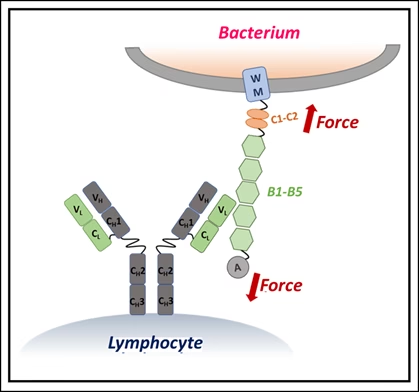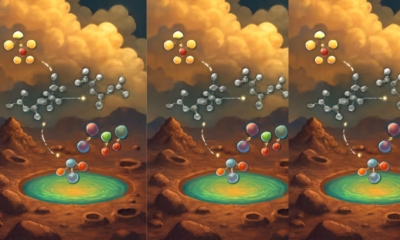The Sciences
Researchers using mushrooms to clean contaminated water
Mushrooms to the Rescue: UFS Researchers Pioneering Eco-Friendly Water Purification

In an innovative approach to tackle South Africa’s escalating water contamination crisis, researchers at the University of the Free State (UFS) are turning to mushrooms for a natural and effective solution. Led by Prof. Patricks Voua Otomo, an Associate Professor in the Department of Zoology and Entomology, this noted research is exploring the potential of mycofiltration — the use of fungal mycelia for purifying polluted water.
South Africa faces a severe water treatment crisis, with a 2022 Green Drop Report revealing that fewer than 3% of the country’s 850 wastewater systems are compliant with required standards. This inadequacy exacerbates pollution in river systems, impacting both human health and environmental sustainability.

The United Nations’ Sustainable Development Goals (SDGs) underscore the urgency of addressing water quality. By 2030, billions are projected to still lack access to safe water, with targets aiming to enhance water quality and reduce pollution significantly.
Prof. Voua Otomo’s research focuses on the pollution drivers in the Qwaqwa region and explores solutions to mitigate their effects. His work highlights the local challenges posed by inadequate sewage sludge management and direct waste disposal into waterways, which has led to alarming levels of pharmaceuticals like anti-inflammatories, HIV medicines, and epilepsy drugs contaminating rivers.
To counteract this, Prof. Voua Otomo and his team are harnessing the power of fungi through mycofiltration. This method utilizes fungal mycelia to filter contaminants from water. The research, detailed in the UFS 2023 Impact Report, has shown promising results. For instance, a mycofilter using Pleurotus ostreatus (oyster mushrooms) successfully removed up to 94% of iron (III) and 31% of the pesticide imidacloprid from contaminated water.
“Mycofiltration works through adsorption, where contaminants adhere to the fungal surface,” explains Prof. Voua Otomo. The process involves using snails as bioindicators to assess improvements in water quality post-filtration.
The initiative, spearheaded by final-year PhD student Sanele Mnkandla, has potential beyond small-scale tests. The researchers are working on scaling up the technology to treat larger bodies of water, with varying filter sizes tailored to the volume and type of contaminants. Depending on the scale, filtration could take from minutes to days.

Prof. Voua Otomo’s team is also investigating local applications, such as rainwater harvesting, to enhance the technology’s utility. The ongoing research, which includes technical notes and proof-of-concept studies, suggests that mycofiltration is a viable and cost-effective method for water remediation in South Africa.
This innovative approach offers hope for addressing the critical issue of water pollution, making mushrooms not just a food source but also a potential key player in safeguarding water resources.
Health
Giant Human Antibody Found to Act Like a Brace Against Bacterial Toxins
This synergistic bracing action gives IgM a unique advantage in neutralizing bacterial toxins that are exposed to mechanical forces inside the body

Our immune system’s largest antibody, IgM, has revealed a hidden superpower — it doesn’t just latch onto harmful microbes, it can also act like a brace, mechanically stabilizing bacterial toxins and stopping them from wreaking havoc inside our bodies.
A team of scientists from the S.N. Bose National Centre for Basic Sciences (SNBNCBS) in Kolkata, India, an autonomous institute under the Department of Science and Technology (DST), made this discovery in a recent study. The team reports that IgM can mechanically stiffen bacterial proteins, preventing them from unfolding or losing shape under physical stress.
“This changes the way we think about antibodies,” the researchers said in a media statement. “Traditionally, antibodies are seen as chemical keys that unlock and disable pathogens. But we show they can also serve as mechanical engineers, altering the physical properties of proteins to protect human cells.”
Unlocking a new antibody role
Our immune system produces many different antibodies, each with a distinct function. IgM, the largest and one of the very first antibodies generated when our body detects an infection, has long been recognized for its front-line defense role. But until now, little was known about its ability to physically stabilize dangerous bacterial proteins.
The SNBNCBS study focused on Protein L, a molecule produced by Finegoldia magna. This bacterium is generally harmless but can become pathogenic in certain situations. Protein L acts as a “superantigen,” binding to parts of antibodies in unusual ways and interfering with immune responses.

Using single-molecule force spectroscopy — a high-precision method that applies minuscule forces to individual molecules — the researchers discovered that when IgM binds Protein L, the bacterial protein becomes more resistant to mechanical stress. In effect, IgM braces the molecule, preventing it from unfolding under physiological forces, such as those exerted by blood flow or immune cell pressure.
Why size matters
The stabilizing effect depended on IgM concentration: more IgM meant stronger resistance. Simulations showed that this is because IgM’s large structure carries multiple binding sites, allowing it to clamp onto Protein L at several locations simultaneously. Smaller antibodies lack this kind of stabilizing network.
“This synergistic bracing action gives IgM a unique advantage in neutralizing bacterial toxins that are exposed to mechanical forces inside the body,” the researchers explained.
The finding highlights an overlooked dimension of how our immune system works — antibodies don’t merely bind chemically but can also act as mechanical modulators, physically disarming toxins.
Such insights could open a new frontier in drug development, where future therapies may involve engineering antibodies to stiffen harmful proteins, effectively locking them in a harmless state.
The study suggests that by harnessing this natural bracing mechanism, scientists may be able to design innovative treatments that go beyond traditional antibody functions.
Math
Researchers Unveil Breakthrough in Efficient Machine Learning with Symmetric Data

MIT researchers have developed the first mathematically proven method for training machine learning models that can efficiently interpret symmetric data—an advance that could significantly enhance the accuracy and speed of AI systems in fields ranging from drug discovery to climate analysis.
In traditional drug discovery, for example, a human looking at a rotated image of a molecule can easily recognize it as the same compound. However, standard machine learning models may misclassify the rotated image as a completely new molecule, highlighting a blind spot in current AI approaches. This shortcoming stems from the concept of symmetry, where an object’s fundamental properties remain unchanged even when it undergoes transformations like rotation.
“If a drug discovery model doesn’t understand symmetry, it could make inaccurate predictions about molecular properties,” the researchers explained. While some empirical techniques have shown promise, there was previously no provably efficient way to train models that rigorously account for symmetry—until now.
“These symmetries are important because they are some sort of information that nature is telling us about the data, and we should take it into account in our machine-learning models. We’ve now shown that it is possible to do machine-learning with symmetric data in an efficient way,” said Behrooz Tahmasebi, MIT graduate student and co-lead author of the new study, in a media statement.
The research, recently presented at the International Conference on Machine Learning, is co-authored by fellow MIT graduate student Ashkan Soleymani (co-lead author), Stefanie Jegelka (associate professor of EECS, IDSS member, and CSAIL member), and Patrick Jaillet (Dugald C. Jackson Professor of Electrical Engineering and Computer Science and principal investigator at LIDS).
Rethinking how AI sees the world
Symmetric data appears across numerous scientific disciplines. For instance, a model capable of recognizing an object irrespective of its position in an image demonstrates such symmetry. Without built-in mechanisms to process these patterns, machine learning models can make more mistakes and require massive datasets for training. Conversely, models that leverage symmetry can work faster and with fewer data points.
“Graph neural networks are fast and efficient, and they take care of symmetry quite well, but nobody really knows what these models are learning or why they work. Understanding GNNs is a main motivation of our work, so we started with a theoretical evaluation of what happens when data are symmetric,” Tahmasebi noted.
The MIT researchers explored the trade-off between how much data a model needs and the computational effort required. Their resulting algorithm brings symmetry to the fore, allowing models to learn from fewer examples without spending excessive computing resources.
Blending algebra and geometry
The team combined strategies from both algebra and geometry, reformulating the problem so the machine learning model could efficiently process the inherent symmetries in the data. This innovative blend results in an optimization problem that is computationally tractable and requires fewer training samples.
“Most of the theory and applications were focusing on either algebra or geometry. Here we just combined them,” explained Tahmasebi.
By demonstrating that symmetry-aware training can be both accurate and efficient, the breakthrough paves the way for the next generation of neural network architectures, which promise to be more precise and less resource-intensive than conventional models.
“Once we know that better, we can design more interpretable, more robust, and more efficient neural network architectures,” added Soleymani.
This foundational advance is expected to influence future research in diverse applications, including materials science, astronomy, and climate modeling, wherever symmetry in data is a key feature.
Health
Researchers Develop Low-Cost Sensor for Real-Time Detection of Toxic Sulfur Dioxide Gas
Sulfur dioxide, a toxic air pollutant primarily released from vehicle exhaust and industrial processes, is notorious for triggering respiratory irritation, asthma attacks, and long-term lung damage.

In a significant breakthrough for environmental monitoring and public health, scientists from the Centre for Nano and Soft Matter Sciences (CeNS), Bengaluru, India, have developed an affordable and highly sensitive sensor capable of detecting sulfur dioxide (SO₂) gas at extremely low concentrations.
Sulfur dioxide, a toxic air pollutant primarily released from vehicle exhaust and industrial processes, is notorious for triggering respiratory irritation, asthma attacks, and long-term lung damage. Monitoring its presence in real time is essential, but existing technologies are often expensive, power-hungry, or ineffective at detecting the gas at trace levels.
To address this gap, the CeNS team, under the leadership of Dr. S. Angappane, has engineered a novel sensor by combining two metal oxides — nickel oxide (NiO) and neodymium nickelate (NdNiO₃). NiO serves as the receptor that captures SO₂ molecules, while NdNiO₃ acts as a transducer that converts the chemical interaction into an electrical signal. This innovative design enables the sensor to detect SO₂ at concentrations as low as 320 parts per billion (ppb), outperforming many commercial alternatives.
Speaking about the development, Dr. Angappane said in a media statement, “This sensor system not only advances the sensitivity benchmark but also brings real-time gas monitoring within reach for a wider range of users. It demonstrates how smart materials can provide practical solutions for real-world environmental challenges.”

The CeNS team has also built a portable prototype incorporating the sensor. It features a user-friendly threshold-triggered alert system with color-coded indicators: green for safe levels, yellow for warning, and red for danger. This visual approach ensures that even non-specialist users can understand and respond to pollution risks instantly. Its compact size and lightweight design make it ideal for deployment in industrial zones, urban neighborhoods, and enclosed environments requiring continuous air quality surveillance.
The sensor system was conceptualized and designed by Mr. Vishnu G Nath, with key contributions from Dr. Shalini Tomar, Mr. Nikhil N. Rao, Dr. Muhammed Safeer Naduvil Kovilakath, Dr. Neena S. John, Dr. Satadeep Bhattacharjee, and Prof. Seung-Cheol Lee. The research findings were recently published in the journal Small.
With this innovation, CeNS reinforces the role of advanced materials science in developing cost-effective technologies that protect both public health and the environment.
-

 Space & Physics5 months ago
Space & Physics5 months agoCould dark energy be a trick played by time?
-

 Women In Science6 months ago
Women In Science6 months agoNeena Gupta: Shaping the Future of Algebraic Geometry
-

 Space & Physics5 months ago
Space & Physics5 months agoSunita Williams aged less in space due to time dilation
-

 Know The Scientist6 months ago
Know The Scientist6 months agoMysterious, resilient, and radiant: The timeless legacy of Marie Curie
-

 Earth5 months ago
Earth5 months ago122 Forests, 3.2 Million Trees: How One Man Built the World’s Largest Miyawaki Forest
-

 Learning & Teaching5 months ago
Learning & Teaching5 months agoHow Understanding Individual Learning Styles Can Transform Education
-

 Earth5 months ago
Earth5 months agoHow Tuna and Swordfish Hunt in the Deep; MIT Oceanographers find the answer
-

 Space & Physics5 months ago
Space & Physics5 months agoDid JWST detect “signs of life” in an alien planet?



















